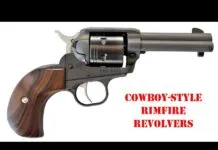Bolt-action 22 rifles are among the most basic and useful of all firearms. They are fine trainers and excellent tools for a variety of uses limited only by the imagination of the owner. We’ve seen ‘em used for just about anything, and about the only constant is that decent 22 bolt rifles generally have long and useful lives.
The street price of the Marlin Model 980S rifle is about $250, averaging three sources. As such, it’s a better bargain than the Winchester, and much easier found than the old Marlin 80 DL. The Marlin’s black synthetic stock had excellent checkering, and the stainless metal had a finish that would shame many costlier rifles. The trigger guard was synthetic, and seemed to be very sturdy. The older Marlin also had a plastic guard, but not as nice as this new one. The only thing we didn’t like about this rifle’s looks was that the magazine hung down like an afterthought. We found it took two hands to remove the magazine, which we considered to be a safety feature.
The next thing that caught our eye was the bright-orange front-sight insert. This, we found, stood out well against nearly any background. We wished for a good aperture rear sight to use with it, but one is not offered. Instead the rear sight was the old “buckhorn” type with stepped wedge for elevation adjustments against the spring of the sight leaf itself. A button on the wedge made this an easy process. Windage was by drifting either the rear or front elements.
The stock had a molded-in buttplate that was integral with the stock. This gave a clean, uncluttered look that we liked. In fact, the overall look and feel of this rifle was that of a full-size big-game rifle. The trigger pull was stiff but clean on the break. The Marlin had clearly marked Safe and Fire positions to the rocking lever at the right rear corner of the action. Bolt removal was by pressing the trigger, a feature shared by all three rifles. Extraction was by two opposing sprung fingers, again as in all three rifles. This Marlin had the biggest extractors.
All three rifles’ magazines required some dexterity to load. This one held seven rounds. The magazine fit solidly and securely into the rifle. The rifle fed all rounds well and ejected them quite forcefully, a quality lacking in the other two rifles.
We tried the rifle with its iron sights at 50 yards, and groups were not as good as we got with the other two rifles, which had an aperture sight and a scope to help them. To make the test fair we installed a 12X Leupold in tip-off rings, using the grooves in the Marlin’s receiver. This helped things, but didn’t make this into a tackdriver by any means. Best groups were with Federal Classic, at 0.9 inch on average. There were no failures to feed, fire, or eject.




























